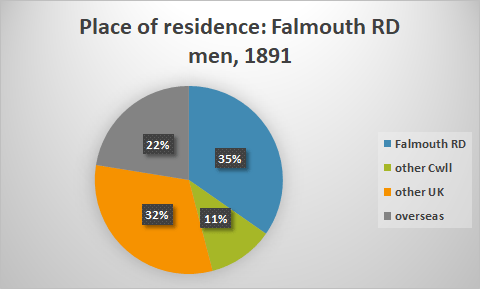Falmouth was, and is, different, often cited as the atypical Cornish town. More than any other place in Cornwall, Falmouth’s horizons seem to look outwards rather than inwards. It emerged late, a new town of the seventeenth century nestling on the sheltered western side of the Fal estuary and quickly elbowing aside its older medieval neighbour of Penryn, just upriver. It then prospered on the back of trade and empire.
In the Napoleonic Wars Falmouth was thrust into the front line in the maritime wars against France. Already, its packet ships were essential links in Britain’s growing global communications chain. The constant toing and froing of merchant shipping and the Royal Navy helped to make Falmouth more culturally diverse than most other places in Cornwall and, indeed, in England.
Even when the railway and the telegraph combined to render the packet ships irrelevant Falmouth remained different. For example, its early twentieth century local politics were more reflective of class antagonisms than other places in Cornwall. In the early twenty-first century its status as Cornwall’s university town provides opportunities and problems unknown in other Cornish towns.

Given this, the migratory experience of those born in the Falmouth registration district (RD) around 1850 was perhaps less different than we might expect. Its boys were somewhat more likely to have departed Cornwall, although no more so than those from south-east Cornwall at Liskeard or St Germans. Those leaving were rather more often found in the rest of the British Isles than overseas, although the proportion of male emigrants from the whole of the RD was not that much lower than from other west Cornish RDs.
It was a similar situation for girls from Falmouth, although they were much less likely to emigrate than boys. This might hint at the existence of a temporary transatlantic flow of male migrants, not from Falmouth itself but the nearby granite quarries in the hills above Penryn. Many granite quarriers in the late 1800s spent a few years in America before returning home. The girls from the Falmouth RD were distinct in one way; more of them – around a third – left Falmouth for the cities and towns of England than did from any other RD in Cornwall.



A few Falmouth – U.S. ties: Falmouth, Massachusetts was settled in 1660 by Englishmen. Earlier, explorer Bartholomew Gosnold, had sailed from the Port of Falmouth, Cornwall and landed in Massachusetts naming his landing site Cape Cod. Near present day Falmouth is the Woods Hole Oceanographic Institute where oceanographer Robert Ballard set out to rediscover the wreck of the British Liner Titanic, in 1965.
LikeLike